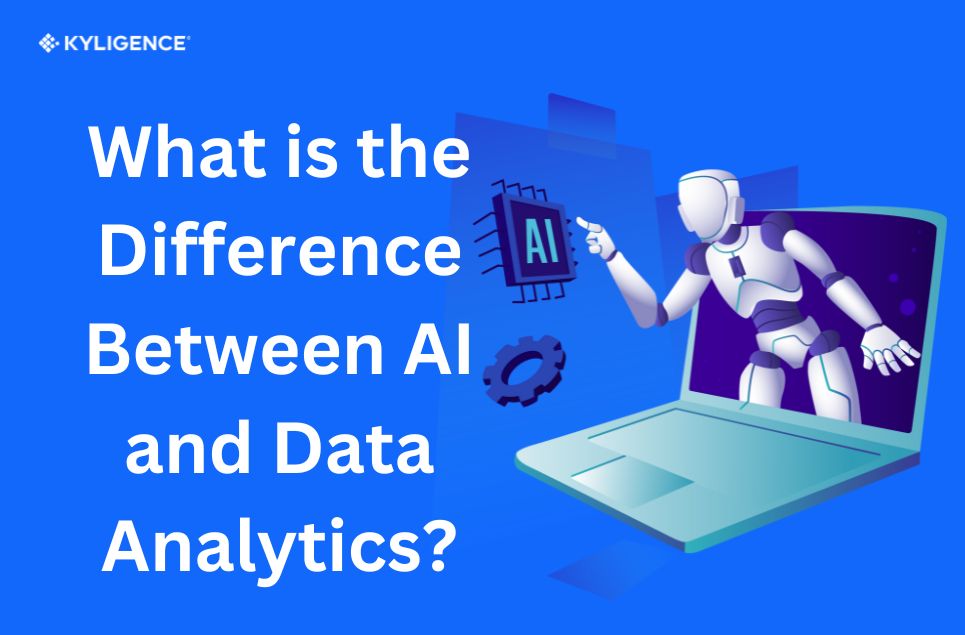Ⓒ 2023 Kyligence, Inc. All rights reserved.

Introduction
The field of technology has witnessed significant advancements in recent years, with artificial intelligence (AI) and data analytics emerging as two prominent areas of focus.
Both AI and data analytics play crucial roles in harnessing the power of data to drive insights and inform decision-making processes.
However, despite their similarities, there are distinct differences between these two domains. In this blog post, we will explore the disparities between AI and data analytics, as well as delve into the interconnection between them.
Additionally, we will discuss the current trends in AI-powered data analytics and introduce the solution for effective AI data analytics.
The Difference between AI and Data Analytics
AI
AI refers to the simulation of human intelligence in machines that are programmed to think and learn like humans.
It encompasses a wide range of techniques that enable computers to perform tasks that typically require human intelligence- such as speech recognition, decision-making, problem-solving, and visual perception.
AI systems can analyze vast amounts of data, identify patterns, make predictions, and adapt their behavior based on experience.
Data Analytics
Data analytics involves examining large datasets to uncover meaningful insights, patterns, correlations, and trends. It aims to extract actionable information from raw data in order to facilitate informed decision-making.
Data analytics encompasses various techniques such as statistical analysis, predictive modeling, data mining, text mining, and business intelligence.
The primary goal of data analytics is to gain valuable insights from structured or unstructured data sources using mathematical models and statistical methods.
While both AI and data analytics deal with processing large volumes of data for extracting insights or making predictions, there are several key differences between the two fields.
Scope and Focus
The scope of AI is broader than that of data analytics. AI aims to replicate human intelligence, simulate cognitive processes, and enable machines to perform tasks that typically require human intervention.
On the other hand, data analytics focuses primarily on analyzing data to uncover patterns, trends, and insights that can drive business decisions.
Methodology and Techniques
AI uses techniques like machine learning, NLP, computer vision, expert systems, and robotics to learn from data, reason with information, understand human language or visual content, and interact with the physical world.
Data analytics relies on statistical analysis, predictive modeling, data mining algorithms, visualization tools, and database management systems to process data efficiently and extract insights.
Goal Orientation
AI aims to create intelligent machines that can autonomously perform tasks without human intervention. It seeks to develop systems that reason like humans, understand complex concepts or emotions, adapt to new situations or environments, and exhibit creativity or problem-solving skills.
On the other hand, data analytics aims to gain actionable insights from data to drive decision-making processes. Data analysts identify patterns or trends within datasets to help organizations optimize operations or improve products/services.
Human Interaction
AI interacts with humans through chatbots, virtual assistants (e.g., Siri or Alexa), recommendation systems (e.g., Netflix or Amazon), or autonomous vehicles. These applications show how AI mimics human behavior by understanding language queries and making personalized recommendations.
Data analytics provides insights for decision-makers within organizations and doesn’t directly interact with end-users. However, its outputs can be used in applications where humans indirectly interact with technology.
The Interconnection between AI and Data Analytics
The interconnection between AI and data analytics enables organizations to leverage the benefits of both fields.
AI technologies, like machine learning and deep learning, enhance data analytics by enabling more advanced analysis techniques and capabilities.
AI-powered algorithms process complex data faster, providing deeper insights into business operations, customer behavior, and market trends.
AI automates repetitive tasks in data analytics, freeing up analysts to focus on interpreting results and making strategic decisions.
AI uncovers hidden patterns or correlations in datasets that may not be apparent through traditional analysis methods alone.
Machine learning algorithms help identify complex relationships within data, leading to valuable insights and opportunities for business growth and innovation.
Current Trends in AI-Powered Data Analytics
Increasing use of Machine Learning Algorithms
A prominent trend in AI-powered data analytics is the increasing use of machine learning algorithms. These algorithms enable computers to learn from large datasets, identify patterns, and make predictions without explicit programming.
Machine learning has proven highly effective in analyzing vast amounts of data and extracting meaningful insights. Organizations are leveraging machine learning to automate processes, optimize operations, and drive innovation.
NLP integration
Another trend in AI-powered data analytics is the integration of natural language processing (NLP) capabilities. NLP enables machines to understand and analyze unstructured text data like customer reviews or social media posts.
This provides valuable insights into customer sentiment and market trends, benefiting industries like marketing, finance, and healthcare.
Deep learning
Deep learning is a powerful tool in AI-powered data analytics. These neural networks automatically learn hierarchical representations of data, excelling in tasks like image recognition, speech recognition, and natural language processing.
Deep learning enables organizations to process complex data types and extract high-level features for analysis.
In addition to these core technologies, there are several other trends contributing to the advancement of AI-powered data analytics.
Edge computing
Edge computing involves processing data at the edge of the network, closer to the source of data generation. This approach reduces latency and enables organizations to analyze data in real-time, which is crucial for applications such as autonomous vehicles or Internet of Things (IoT) devices.
Data visualization tools
Another trend is the increasing use of AI-powered data visualization tools. These tools use AI algorithms to automatically generate visual representations of complex datasets, facilitating interpretation and understanding of information.
Data visualization is crucial in data analytics as it effectively communicates insights and supports decision-making processes.
Conclusion
AI and data analytics are crucial components in today’s technological landscape. While distinct, they are intricately connected in the digital world. The combination of these fields offers immense potential for businesses to harness their data.
By leveraging AI-powered tools like Kyligence Zen and Kyligence Copilot, organizations can unlock valuable insights, make data-driven decisions, and stay ahead in a competitive market. Kyligence provides powerful solutions for managing and analyzing massive amounts of structured and unstructured data.
Try Kyligence today for free or book a demo call to gain deeper insights and make more informed decisions for your business.
